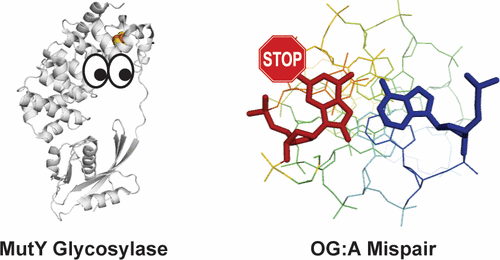当前位置:
X-MOL 学术
›
ACS Chem. Biol.
›
论文详情
Our official English website, www.x-mol.net, welcomes your
feedback! (Note: you will need to create a separate account there.)
Structure–Activity Relationships Reveal Key Features of 8-Oxoguanine: A Mismatch Detection by the MutY Glycosylase
ACS Chemical Biology ( IF 3.5 ) Pub Date : 2017-08-08 00:00:00 , DOI: 10.1021/acschembio.7b00389 Amelia H. Manlove 1 , Paige L. McKibbin 1 , Emily L. Doyle 1 , Chandrima Majumdar 1 , Michelle L. Hamm 2 , Sheila S. David 1
ACS Chemical Biology ( IF 3.5 ) Pub Date : 2017-08-08 00:00:00 , DOI: 10.1021/acschembio.7b00389 Amelia H. Manlove 1 , Paige L. McKibbin 1 , Emily L. Doyle 1 , Chandrima Majumdar 1 , Michelle L. Hamm 2 , Sheila S. David 1
Affiliation

|
Base excision repair glycosylases locate and remove damaged bases in DNA with remarkable specificity. The MutY glycosylases, unusual for their excision of undamaged adenines mispaired to the oxidized base 8-oxoguanine (OG), must recognize both bases of the mispair in order to prevent promutagenic activity. Moreover, MutY must effectively find OG:A mismatches within the context of highly abundant and structurally similar T:A base pairs. Very little is known about the factors that initiate MutY’s interaction with the substrate when it first encounters an intrahelical OG:A mispair, or about the order of recognition checkpoints. Here, we used structure–activity relationships (SAR) to investigate the features that influence the in vitro measured parameters of mismatch affinity and adenine base excision efficiency by E. coli MutY. We also evaluated the impacts of the same substrate alterations on MutY-mediated repair in a cellular context. Our results show that MutY relies strongly on the presence of the OG base and recognizes multiple structural features at different stages of recognition and catalysis to ensure that only inappropriately mispaired adenines are excised. Notably, some OG modifications resulted in more dramatic reductions in cellular repair than in the in vitro kinetic parameters, indicating their importance for initial recognition events needed to locate the mismatch within DNA. Indeed, the initial encounter of MutY with its target base pair may rely on specific interactions with the 2-amino group of OG in the major groove, a feature that distinguishes OG:A from T:A base pairs. These results furthermore suggest that inefficient substrate location in human MutY homologue variants may prove predictive for the early onset colorectal cancer phenotype known as MUTYH-Associated Polyposis, or MAP.
中文翻译:

结构-活性关系揭示了8-氧鸟嘌呤的关键特征:MutY糖基化酶的错配检测。
碱基切除修复糖基化酶以显着的特异性定位并去除DNA中受损的碱基。MutY糖基化酶因其未切除与氧化的8-氧代鸟嘌呤(OG)碱基错配的未受损腺嘌呤而异常,因此必须识别错配的两个碱基,以防止促突变活性。而且,MutY必须在高度丰富且结构相似的T:A碱基对的背景下有效地发现OG:A错配。关于MutY首次遇到螺旋内OG时启动MutY与底物相互作用的因素知之甚少,或者对识别检查点的顺序知之甚少。在这里,我们使用结构-活性关系(SAR)来研究影响体外的特征用大肠杆菌MutY测得错配亲和力和腺嘌呤碱基切除效率的参数。我们还评估了细胞环境中相同的底物改变对MutY介导的修复的影响。我们的结果表明MutY强烈依赖OG碱基的存在,并在识别和催化的不同阶段识别多种结构特征,以确保仅切除不适当错配的腺嘌呤。值得注意的是,与体外相比,某些OG修饰导致细胞修复的减少幅度更大动力学参数,表明它们对于在DNA中定位错配所需的初始识别事件的重要性。实际上,MutY与其靶碱基对的初次接触可能依赖于与大沟中OG的2-氨基基团的特异性相互作用,这是将OG:A与T:A碱基对区分开的特征。这些结果进一步表明,在人类MutY同源变体中低效的底物定位可能被证明可预测MUTYH相关性息肉病或MAP的早期发作性结肠直肠癌表型。
更新日期:2017-08-08
中文翻译:

结构-活性关系揭示了8-氧鸟嘌呤的关键特征:MutY糖基化酶的错配检测。
碱基切除修复糖基化酶以显着的特异性定位并去除DNA中受损的碱基。MutY糖基化酶因其未切除与氧化的8-氧代鸟嘌呤(OG)碱基错配的未受损腺嘌呤而异常,因此必须识别错配的两个碱基,以防止促突变活性。而且,MutY必须在高度丰富且结构相似的T:A碱基对的背景下有效地发现OG:A错配。关于MutY首次遇到螺旋内OG时启动MutY与底物相互作用的因素知之甚少,或者对识别检查点的顺序知之甚少。在这里,我们使用结构-活性关系(SAR)来研究影响体外的特征用大肠杆菌MutY测得错配亲和力和腺嘌呤碱基切除效率的参数。我们还评估了细胞环境中相同的底物改变对MutY介导的修复的影响。我们的结果表明MutY强烈依赖OG碱基的存在,并在识别和催化的不同阶段识别多种结构特征,以确保仅切除不适当错配的腺嘌呤。值得注意的是,与体外相比,某些OG修饰导致细胞修复的减少幅度更大动力学参数,表明它们对于在DNA中定位错配所需的初始识别事件的重要性。实际上,MutY与其靶碱基对的初次接触可能依赖于与大沟中OG的2-氨基基团的特异性相互作用,这是将OG:A与T:A碱基对区分开的特征。这些结果进一步表明,在人类MutY同源变体中低效的底物定位可能被证明可预测MUTYH相关性息肉病或MAP的早期发作性结肠直肠癌表型。











































 京公网安备 11010802027423号
京公网安备 11010802027423号